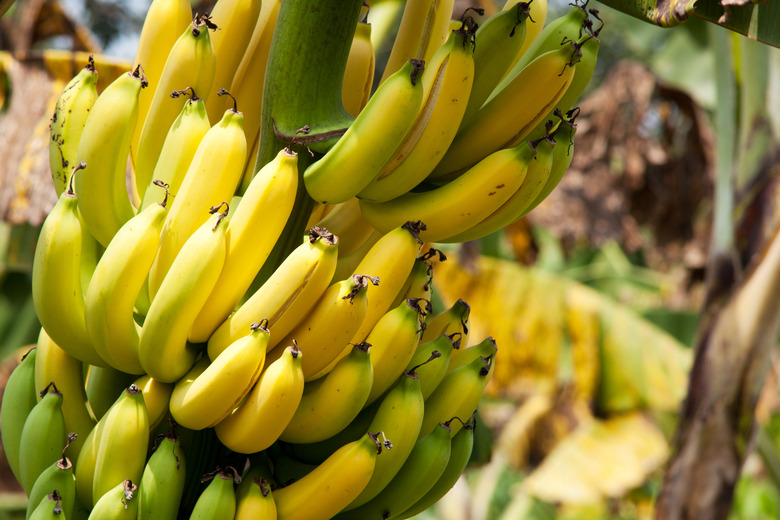Are Banana Plants Toxic?
If your child or pet wanders into the garden and starts chomping on a banana flower or leaf, the result might be "yum," but it won't be illness. No, a banana plant is not toxic. In fact, the leaves of banana (Musa spp., USDA zones 6-11, depending on species and cultivar) are used in cooking across the world, and its flowers are considered delectable edibles among some gourmet cooks. Any part of a plant, however, has the potential to cause an allergic reaction for those with plant-specific sensitivities.
Tip
No part of the banana plant is toxic.
Banana Botany Basics
Banana Botany Basics
The banana is not a tree, but a herbaceous perennial. Its so-called "trunk" is actually called a "pseudostem." This juicy stem is mostly water; in fact, the banana plant is 93 percent water itself. If your pet is thirsty or just curious, it might lick the stem or simply root around in the dirt, uncovering the banana's underground rhizome from which all banana plants grow. Neither the stem nor the rhizome should cause any harm to your pet or child.
From the banana stem uncurls its dramatic leaves, often used in cooking. The stem then produces the banana flower stalk. The female part of the flower appears first, developing into the banana clusters, or "hands," that you find in your supermarket. There is no evidence that any part of the flowers, and certainly not the hands themselves, is toxic.
Using Banana Leaves
Using Banana Leaves
Various cultures, cooks and gourmets make use of banana leaves, either in the garden, as a medicine or in the kitchen. In the garden, leaves are used as mulch, left to lie on the ground under the banana plant or used elsewhere on other plants. Leaves are often used in cooking to wrap meat, curries or rice dishes. Once wrapped, they are typically grilled, steamed or deep-fried. Leaves are also used as platters or plates for a meal. South Indian restaurants might cut discs of banana leaves and place small bites on top. The famous Hawaiian lau lau pork often incorporates banana leaves both while steaming and layered in the imu oven.
Banana leaves are also considered to have medicinal benefits and have been used traditionally in India to treat various ailments, although most of these aren't backed by scientific research. Examples include using them on the skin to treat hives, itching or rashes and also on hair to treat dandruff and promote healthy hair. Somewhat more dubiously they've been used to treat stomach problems such as dysentery and ulcers and to reduce blood glucose levels in diabetics. Banana ash — burned banana leaves — has been used to treat fungal infection.
Warning
There is no current scientific evidence for treating serious conditions with banana leaves, so avoid self-prescribing and be sure to talk to a doctor if you have any serious health issues.
Using Banana Peels and Flowers
Using Banana Peels and Flowers
Not only the leaves, but also the peels and even banana flowers have many uses and are considered edible.
Banana peels are said to help meat, such as chicken breasts, remain juicy during cooking by being placed on top of the cooking meat. Put them inside a plastic container with a perforated lid to attract fruit flies. Rub the inside on an itchy bug bite where the peel's polysaccharides will combat swelling. Even whiten your teeth by rubbing the inside of the peel against your teeth after brushing.
Banana flowers, as well, are among the many types of edible flowers used to garnish or in actual recipes. Called banana hearts, the flower is plucked before it produces fruit. A deep purple-red color, the covering is removed, and the white, tender parts of the blossom are then used, in particular in Southeast Asian cooking.
